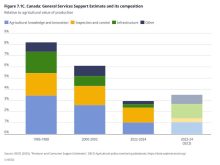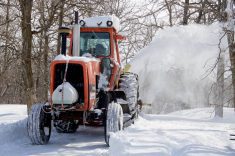April really is the cruelest month.
Or at least it was in Manitoba this year.
Just as some fields, especially in south-central parts of the province, were turning black following Winnipeg’s sixth-snowiest winter on record, an Easter blizzard April 13-15, followed by a second storm days later, buried much of agro-Manitoba under 30 to 85 centimetres of new snow.
Read Also

Unclear food labels hinder Canada’s ‘buy local’ surge
“Maple-washing” on Canadian food packaging makes label claims hard to keep straight and hurts both farmers and consumers trying to buy Canadian, economist says.
After last year’s drought, most farmers welcomed the earlier moisture, but it has also led to growing concern about seeding delays.
The issue came up at a Keystone Agricultural Producers (KAP) online spring advisory council meeting April 13 — and that was before another Colorado low was forecast at press time Friday to dump another 30 to 60 cm of snow on western Manitoba, and perhaps 25 to 80 mm of rain to the east.
Why it matters: Research shows early-seeded crops, on average, yield better. Farmers can’t change the weather, but there are strategies, such as different nutrient management tactics, to help during the seeding crunch.
The same KAP meeting featured Don Flaten, a retired University of Manitoba soil scientist, who warned that high fertilizer and crop prices have moved farmers up to the high-stakes poker table.
“Finding the sweet spot is more challenging and more risky,” Flaten said in an interview April 20. “Even though there are very few things for sure in agriculture, there are management practices we can use to reduce some of those risks. A lot of those are well-established, tried-and-true principles of good nutrient management, but we need to be even more careful than usual in the current market circumstances.”
Despite the possibility of delayed seeding, many farmers are in a good spot because they applied some or all of their nitrogen last fall, and many fields had a lot of residual nitrogen due to drought-reduced yields in 2021, Manitoba Agriculture’s soil fertility specialist John Heard said in an interview April 19.
But farmers who still have to apply nitrogen this spring also have options, he added.
“With nitrogen, the advantage is you can put it all on up front or at seeding or after, but in a year when things are maybe tight for time, that’s when farmers might have an opportunity to exploit an after-seeding option,” he said.

A year ago, some Manitoba farmers were seeding in late April. Manitoba Agriculture’s June 8, 2021 weekly crop report said two per cent of the province’s approximately 10 million acres of farmland was sown before May 1 that year. The four-year average put seeding at three per cent complete by that point in the season.
By the last week of May 2021, 91 per cent of acres had been sown, compared to a four-year average of 93 per cent.
“The seeding this spring is going to be delayed dramatically and there’s lots of overland flooding in the fields that I’ve seen,” Starbuck farmer Doug Livingston told KAP’s advisory council.
“I suspect that in our area there will be unseeded acres this year,” Lockport farmer Craig Riese also said. “We had a lot of snow prior to the snowstorm, and this is only going to compound that problem. There will be snow bleeding out of the bush near ’til June.”
Minnedosa farmer Neil Galbraith reported that, in his area with its higher elevation, 10 to 25 per cent of fields still had old snow before the Easter storm.
“We’ve got two- or three-foot drifts here now… there’s a lot of snow in the bush,” he said.
“So I would expect unseeded acres this spring, or if not unseeded, seeded in June, because we’re going to have things trickling across fields for all of May, I would think, unless it got really warm, really quick, which it says it’s not going to.”
But other farmers, as of the second-last week of April, were more sanguine.
“Around this date in 1997 (during the Flood of the Century), we were sandbagging,” Roland farmer Bob Bartley said in an interview April 19. “It appears that most of us won’t have to sandbag (this year).
“Since it’s still snowing, that’s putting more bushels in the bin next fall I think. But there does come a point when we’ve got to get going.”

His largest concern, he added, is not the late spring, but rather market pressures from conflict in Ukraine and “how the world is depending on us to grow a crop.”
Edward Grenier, who farms with family on the escarpment near St. Leon, is used to seeding a bit later than those who farm at lower elevations. He tries not to worry about things he can’t control.
Despite an April snowstorm in 1997 leading to major flooding in the Red River Valley, most farmers there still completed seeding ahead of those on the escarpment, Grenier said.
Seeding did start earlier last year but cold weather and flea beetles also wreaked havoc on canola crops, he noted.
“With warm soil, the canola plants pops (sic) out of the ground and it’s growing quickly and it outgrows flea beetles, but when you get a frost and the crop stalls, that’s when it seems the flea beetles seem to ravage things,” Grenier said.
“I have records of every year I have run the drill and there are way more years that we seed the 15th of May than we seed the 28th of April up on the escarpment,” he noted.
Both Bartley and Grenier agreed that, if the coming storm was mostly rain, it might help melt snow from the previous storm, helping farmers get on the land sooner.
Manitoba farmers needed the moisture, but the late timing of the precipitation is a concern, Manitoba Agriculture oilseed specialist and weekly crop report editor Dane Froese said in an interview April 19.
“But I keep telling people we haven’t lost a crop at the end of April,” he said. “It’s still April… and the good news is we’ve got a lot of fertilizer down already.
“We have enough moisture now to start off with really good germination, so long as we can get into the fields to seed. Seeding in the middle of May isn’t the worst thing in the world either. We’re going to have warmer soils by the time we do seed. We may be a little bit later than we’d like.”
He added that a late spring often also comes with a late fall, allowing crops to reach maturity, assuming there is heat in July.
Still, Froese understands farmers’ unease. Most will be using this time “to make sure their machinery is ready to rock and roll, because as soon as we get good ground travel conditions, the flood gates will open and we’re going to see everybody on the fields trying to get things done all at once. I’d advise farmers to make sure their logistics are in order, because relying on a custom applicator unit might be a little bit hard to get in time during a rushed seeding process this year.”
Manitoba farmers can usually seed about 2.5 million acres, or 25 per cent of the province’s farmland, in a week if land is accessible, Froese said. That takes into account waiting for warmer soils and reduced frost risk for certain crops.
“If we were in an absolute time crunch and running up against a seeding deadline or the middle of June or something like that, we could push that number faster again,” he said.
In Manitoba, farmers have until June 20 to seed cereals and qualify for crop insurance. Their coverage includes excess moisture insurance if wet conditions prevent seeding (see below).

In 2011, a record three million insured acres went unseeded due to excess moisture, resulting in payouts of $162.3 million.
Betting on fertility
Farming is always a gamble, but with both high fertilizer and crop prices, the risks are greater, Flaten and Heard said in separate interviews. Farmers don’t want to underfertilize and risk losing yield when prices are strong, but overapplying expensive nitrogen will cut profits.
An online calculator (available at the Province of Manitoba website), takes both into account when helping the farmer find optimum rates for wheat and canola, Flaten said.
One critical variable — moisture — isn’t short this year.
Studies show about 35 to 40 per cent of Manitoba’s nitrogen is fall applied.
“Some (fertilizer) dealers say we had a record fall and right now that sounds awfully sweet,” Heard said, given seeding could be delayed.
Ideally, farmers will know from a fall soil test how much residual nitrogen there is, Flaten noted.
“On average in Manitoba, it’s probably 30 per cent of the fields that had more than 100 pounds (an acre) of leftover nitrogen,” he said, based on soil test data collected by the soil nutrient testing firm AgVise. “That’s enough for a 50-bushel wheat crop right there.”
In the Interlake, where drought was most severe, fields are averaging over 100 pounds an acre of residual nitrogen.
“At today’s prices, that’s well over $100 (an acre) of leftover nitrogen sitting there,” Flaten said.

It should still be there, but with caveats. If there was a lot of fall regrowth, for example, some of that nitrogen could be tied up and not immediately available. Nitrogen can also leach in waterlogged fields, especially with sandy soils, or gas off.
To know, farmers might consider testing those fields this spring. But as of April 19, the nitrogen should still be there, especially if it was banded last fall when soils were cold, Heard said.
“I think, to this point, things are still pretty static in the soil,” he said. “Even though the soil is wet, because it’s cool most of that nitrogen should be in a stabilized form.”
Farmers should consider planting crops like canola and wheat on fields with the highest residual nitrogen and crops that require less, such as soybeans, on fields with lower levels, Flaten said, so long as it also fits in the rotation.
Ideally, nitrogen that needs to be applied this year will be banded, but far enough from the seed to prevent toxicity, Flaten said. But that can also be a challenge under wet conditions, resulting in a poor seedbed, Heard noted.
While broadcasting nitrogen is less efficient and can result in higher greenhouse gas emissions, farmers can mitigate those concerns by working it in right away, according to Heard.
“One of the worst halfway measures is probably tickling it in with harrowing or vertically tilling,” he said. “If we put our nitrogen in moist soil and then don’t get rain, losses can occur as the moisture wicks off if that nitrogen wasn’t placed deep enough to be safe.”
Just applying extra nitrogen to make up for potential losses isn’t acceptable, Heard said.
“That’s not good for the environment and it’s very expensive right now and with (tight) nitrogen supplies, that’s irresponsible use of an important input,” he said.
Broadcasting shortly after seeding can work too if it rains soon after, according to Flaten. For a wider window, farmers can apply slow-release nitrogen.
Farmers unsure of whether their crop has enough nitrogen can up the rate on a portion of a field and later compare plant colour to the rest of the field, Heard said. If the higher-fertilized crop is greener, the farmer can consider adding more nitrogen early in the growing season. For cereals, it’s up to flag-leaf emergence.
Splitting nitrogen applications is akin to betting on the outcome of a hockey game after the first period, Heard said. In both cases, there’s more information about the possible outcome, making it a surer bet.
But a later nitrogen application only works if it rains soon after, he cautioned.
There’s less flexibility with phosphorus and potassium applications, Flaten said. Both must be applied at seeding and relatively close to the seed because they are less water soluble.
“Most people have that built into their systems anyway,” Heard said.
Heard added that he’s not overly concerned about late seeding just yet.
“Many farmers have been here before,” he said. “They will know what to do. This will put a few ideas in front of them. We’ll push the panic button in another 10 days if we don’t lose a bunch of this snow.”
















